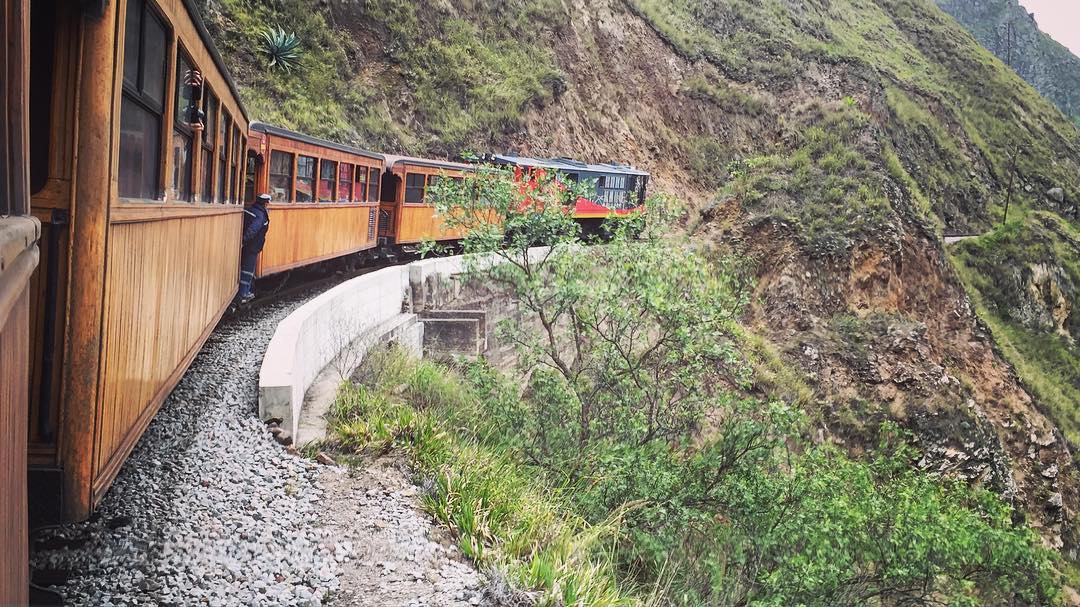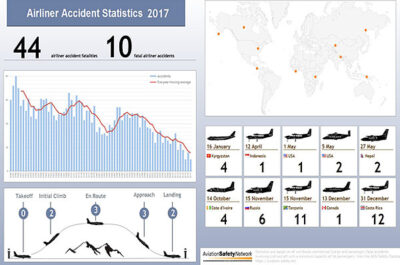In 2018, the Aviation Safety Network (ASN) recorded 15 airliner accidents which amounted to 556 individual deaths, which is more than double recorded in 2017 (the safest year on record for the airline industry).
These risky routes are not for the faint-hearted, from railways built on stilts attached to the Indonesian hillside, to the deadly Bolivian mountain road where vehicles are forced to pass within a hair's breadth of each other.
Risky Routes – The Deadly Statistics
In 2018, the Aviation Safety Network (ASN) recorded 15 airliner accidents which amounted to 556 individual deaths, which is more than double recorded in 2017 (the safest year on record for the airline industry).
On the roads the overall number of people killed each year is increasing, hitting 1.35m in 2018. This is equivalent to 1 death every 24 seconds according to data from Global Alliance of NGOs for Road Safety. Interestingly, the risk of dying on the road is three times higher for those living in low-income countries than in high-income countries and this is the number one cause of death for those aged five to 29.
Meanwhile on the railways, a there were a total of 39 accidents reported globally, with 175 fatalities in 2018. In comparison with 2017, there were 6% fewer deaths on the railways globally.
Whether you’re travelling by land, air, sea or rail, the team at 1st Move International have put together a list of the 11 most dangerous transport routes, which would give even the bravest traveller pause for thought.
Risky Roads
Yungas Road | The Death Road | Bolivia
The North Yungas Road in Bolivia is often referred to as ‘The Death Road’, claiming up to 300 lives each and every year. The road is an essential shipping route for locals and businesses alike.
In the clip from BBC’s motoring show Top Gear, the presenters come face-to-face with the sheer drops and narrow passing points. Clinging to the Bolivian mountainside, the 12 ft wide road forces trucks to pass within centimetres of each other, coupled with the 15,000ft sheer drops, mudslides and rock avalanches.
Sichuan-Tibet Highway | China
A healthy dose of caution is required when driving along this risky route. The Sichuan-Tibet Highway crosses 14 of the highest mountains in between Chengdu in Sichuan and Lhasa in Tibet.
Stretching a mammoth 2,028km, the route is fraught with danger from deep, water-filled potholes, landslides and rock avalanches which could easily knock even the most experienced driver into the ravine below.
The Canning Stock Route | Australia
The Canning Stock Route is one of the most iconic roads in the whole of Australia. Running from Halls Creek, all the way to Wiluna in the midwest. Traditionally used by farmers to transport their stock, it’s now more frequently used by thrill-seekers taking 4-wheel drive adventures through the sandy, aboriginal terrain.
The route is rich in history and indigenous culture, but is also one of the most treacherous. Crossing three desserts (Gibson Desert, Little Sandy Desert and the Great Sandy Desert) it should come as no surprise to learn that there’s very little fresh water or fuel to be found along the sandy route.
Whilst the route might not appear dangerous at first glance, it’s lined with graves of the travellers who have perished due to the lack of water along the way.
Spine-Chilling Shipping Routes
Bermuda Triangle | Bermuda
Spanning almost 500,000 square miles, the Bermuda Triangle is a region in the North Atlantic Ocean, where a disproportionate amount of ships and aircrafts have disappeared under mysterious circumstances.
Stretching between Bermuda to Puerto Rico, the route is one of the most heavily travelled, with ships routinely passing through this area destined for the US, Europe and the Caribbean, not to mention the cruise ships and commercial airlines that regularly fly through the Bermuda Triangle’s airspace.
Tales of shipwrecks and disappearing aircraft have fascinated audiences for many years, with some of the unexplainable incidents attributed to paranormal activity or even extraterrestrial beings.
South China Sea | Strait of Malacca | China
When you think of piracy, Somalia and the Indian Ocean immediately springs to mind, but in reality there are far more dangerous shipping superhighways.
Stretching from West Malaysia to the tip of Indonesia, the Strait of Malacca is one of the most travelled shipping routes in the world combined with the fact that just over a fifth (41%) of the world’s pirate attacks happened in Asia between 1995 and 2013.
One such incident in 2014 happened when nine fully armed pirates hijacked a tanker bound for Honduras. The pirates siphoned more than 2000t of oil from the tanker, injuring three crew members and causing irreparable damage to the ship’s communication equipment.
Somali Coastline | Somalia
Perhaps one of the most well known areas for piracy, the coast of Somalia is one of the most risky routes you can travel along with 435 piracy incidents reported between 2009 and 2013.
The root cause of piracy in this region is reported to be related to illegal overfishing in the ‘90s by international vessels. In response, the Somali fisherman (who felt their livelihoods were being threatened) formed vigilante groups in order to regain control of the waters off the coast of Somalia. Piracy in the area peaked in 2011, with over 200 attacks recorded.
Frightening Flight Paths
Flying over the Himalayas | India/Nepal
The Himalayas can throw up some serious mountain weather when the wind and weather collide, making air travel over this region risky business.
Route L888 is one of the most troublesome routes, plagued with frequent bone-rattling turbulence. This route is known as the ‘Silk Road’ of the airways making it an important route for cargo and commercial flights alike.
The airport of Lukla in Nepal is often cited as the most challenging airstrip in the world and the starting point for many Mount Everest adventures. The airstrip is carved into the hillside 9000 ft above the ravine below. The runway is just 1,500 ft long and 60 ft wide ending in a flat mountain wall, making landing a challenge for even the most experienced pilots.
Ukraine Airspace | Ukraine
Major global airlines have boycotted Ukrainian airspace following the Malaysian Airlines flight MH17 incident in 2014, killing all 298 people in board.
British Airways, Qantas and Cathay Pacific are amongst the airlines making detours to avoid the airspace over Ukraine after it was revealed that the alleged cause of the MH17 incident was a surface-to-air missile.
The Ukrainian Government declared it unsafe for aircraft to enter the airspace over Eastern Ukraine below an altitude of 32,000 ft, due to the possibility of anti-aircraft weapons.
Nerve-Racking Railroads
Argo Gede Railroad | Indonesia
Clinging to the cliffs high on the Indonesian hillside, the Argo Gede railroad is extremely popular with tourists looking to travel between Bandung and Jakarta. Weaving through tea plantations incredible mountain scenery and rice fields.
Around halfway through the 3-hour journey, the train suddenly arrives at the Cikurutug pylon trestle bridge. This section of the route is completely unsupported and unfenced, which led to a major derailment in 2002.
Chennai-Rameswaram Route | India
The Chennai-Rameswaram railroad is one of the more extreme ways to cross the channel between the two islands in the South East coast of India. Built over the sea, this railroad connects two very popular pilgrimage locations for tourists and locals.
The railroad is elevated above the water, allowing for ferries and ships to pass beneath the railroad, however this doesn’t stop the track being flooded on a regular basis by the choppy sea. In addition to this, strong winds can also affect the crossing, forcing the train to slow to just 4 metres per second.
Nose of the Devil Railroad | Ecuador
One of the most popular, yet most dangerous sections of the Trans-Andean railroad is the Devil’s Nose section. Zig-zagging through the mountains, climbing more than 500 ft in just 12.5km.
The 12.5km Devil’s Nose section of the line runs between Alausi to Sibambe and is one of the most notorious stretches of railway, earning its name from the steep cliffs, inclines and winding turns.
During the construction of the Devil’s Nose Section, 4,000 workers were brought in, with around 200 of them dying whilst working on the project. In addition to the perilous working conditions, the area suffered through earth tremors, heavy rainfall and poisonous creatures, to name just a few.
Vicky is the co-founder of TravelDailyNews Media Network where she is the Editor-in Chief. She is also responsible for the daily operation and the financial policy. She holds a Bachelor's degree in Tourism Business Administration from the Technical University of Athens and a Master in Business Administration (MBA) from the University of Wales.
She has many years of both academic and industrial experience within the travel industry. She has written/edited numerous articles in various tourism magazines.






































































































































































